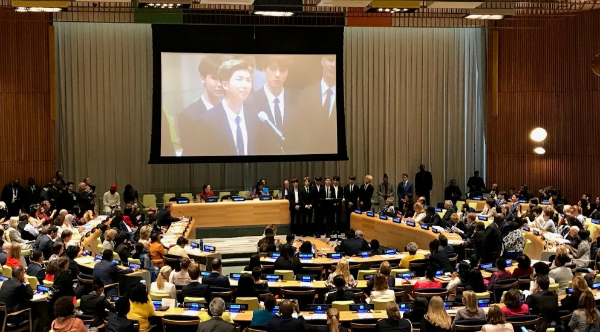How Do We Shape the Workforce of the Future? Ask a Kid.
By Nate Hurst, Chief Sustainability and Social Impact Officer at HP
When the target date for achieving the Sustainable Development Goals is reached in 2030, my son and his peers will be young adults entering or preparing to enter the workforce. This will be a workforce that is fundamentally different, requiring skills for jobs that haven’t yet been imagined.
This reality was top of mind as I participated in events and discussions associated with the United Nations General Assembly 2018 in New York last week. And it’s a key personal motivator every day in my work at HP to create sustainable impact for all generations. I found myself more inspired and energized than ever at this year’s UNGA by the collective focus by UN Member States, business and organizations to engage and empower youth to shape what that future looks like.
Young People are the Present and the Future
We all benefit from the valuable insights of today’s youth and should be empowering them to reinvent the future. Young people are the first generation of digital natives and are highly socially aware. They are already driving the changes they want to see in the world, innovating solutions to tough social and environmental challenges. We can support their efforts and help them scale these great ideas.
With the launch of the Youth 2030: The United National Youth Strategy, UN Secretary General António Guterres signaled a historic shift from working for youth to working withyouth to solve the global challenges young people will most directly face in the decades ahead.
Chief among them is building skills for the jobs of the future.
Preparing Tomorrow’s Workforce Today
The acceleration of the Fourth Industrial Revolution is transforming the nature of business and jobs faster than workers can adapt. As noted in this video by Generation Unlimited, there are more young people in the world today than ever before—an estimated 1.8 billion aged 15 to 28—yet fewer of them are working. At the same time, jobs requiring key skill-sets remain unfilled. This is already creating an imbalance of skilled labor to meet growing demand, even as unemployment among global youth rises.
And this employment gap is projected to widen in the coming decade. In fact, the Education Commission predicts that by 2030 more than half of the 2 billion youth worldwide will not have the skills or qualifications necessary to participate in the emerging global workforce.
For businesses to remain competitive and sustain a pipeline of future employees and customers, it’s imperative they actively address this gap today.
A new report by the Global Business Coalition for Education and Deloitte Global, “Preparing tomorrow’s workforce for the Fourth Industrial Revolution,” provides an actionable framework for business to start.
The report was created in support of the Youth Skills and Innovation Initiative, which focuses on addressing the disconnect between future jobs and a skilled workforce. To support the Initiative, which was launched just one year ago at UNGA 2017, GBC-Ed convened the Youth Skills and Innovation Commission. This Commission, of which I’m a member, represents a diverse set of industry leaders, academics, policymakers, practitioners—and, importantly, youth—that are collectively sharing evidence and experience to help prepare the workforce of the future.
The GBC-Ed/Deloitte report encourages business leaders to focus on four primary challenges associated with youth workforce development, including reimaging 4IR as a unique opportunity to be welcomed, repositioning programs as systemwide, unified approaches, realigning for scale and impact, and reframing possibilities for marginalized youth, particularly women and girls.
Partnering for Better Outcomes
HP’s Sustainable Impact strategy aligns with this approach, seeing these global challenges as opportunities that are fundamental to our reinvention journey. Our commitment to enabling better learning outcomes for 100 million people by 2025 is rooted in a system-wide approach to reinvent the classroom in ways that create both scale and impact by engaging students, empowering educators, and building strong and vibrant communities.
We partner with organizations like UNICEF, Clooney Foundation for Justice, Microsoft, Education Cannot Wait, UNHCR, and others to reach underserved and marginalized people, including those displaced by crisis or conflict. Check out HP’s 2017 Sustainable Impact Report to learn more about our education and lifelong learning programs that have benefitted 14.5 million people through 2017.
I’m particularly proud that we’re engaging and collaborating with youth advocates through partnerships with organizations like Women Deliver, Black Girls Code, Girl Rising, and Global Citizen to help guide our reinvention journey. These youth are both the present and the future, and are most directly affected by decisions being made. Their ideas and voices must be welcomed, heard, and reflected in the decisions and actions being taken today.
How are you preparing for the workforce of the future, and how do you engage youth in your process? Comment below to share your experiences.



